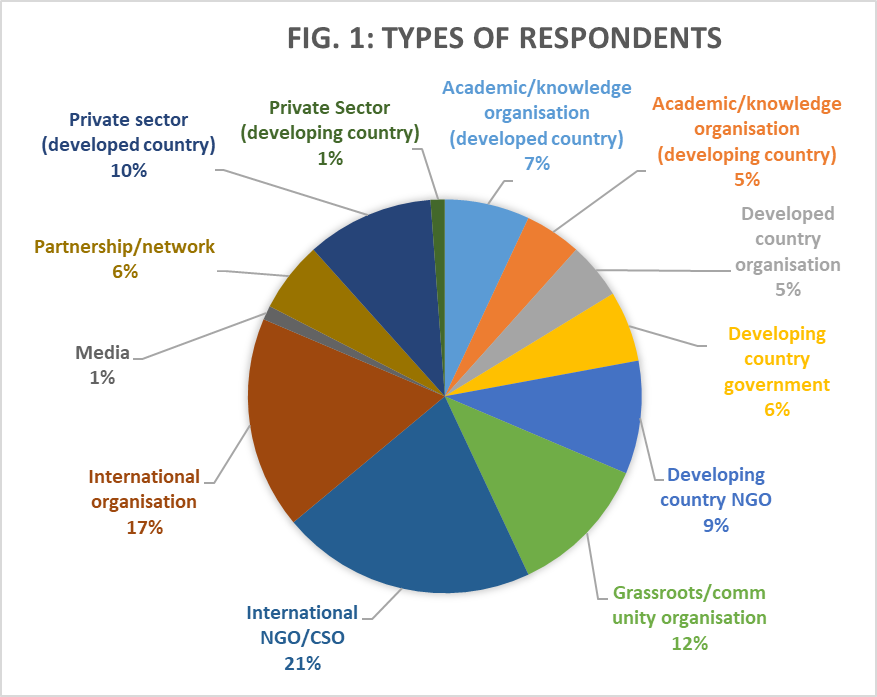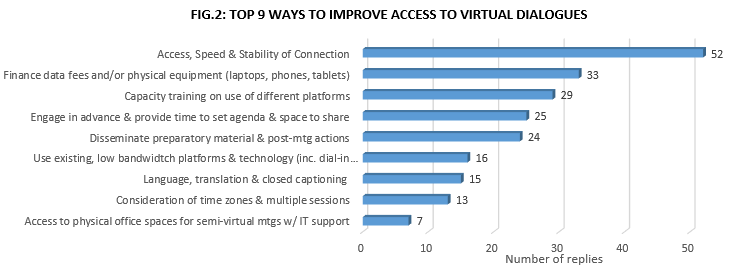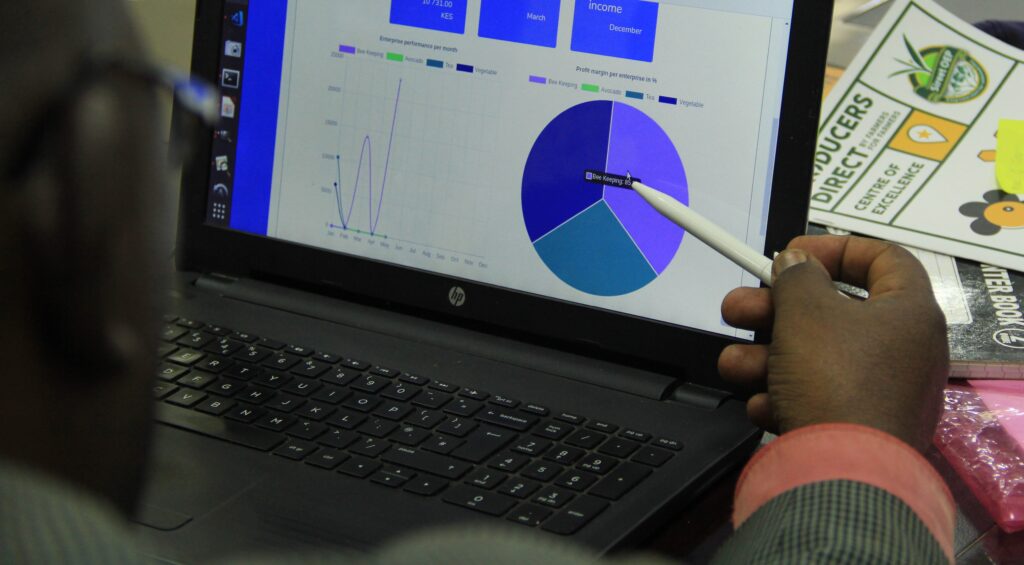The Covid-19 pandemic has been one of the largest global disruptions of modern times. Amid lockdowns, shifting priorities and cancelled events, COVID-19 presents significant challenges in how we work together. However, it also presents an opportunity to design more inclusive dialogues, more engaging formats, and a way to do things differently.
To better understand the opportunities for virtual engagement and how to avoid “digital exclusion,” especially for grassroots and community-based organisation (CBOs), GRP circulated a SurveyMonkey. A total of 88 set of responses were collected from a wide range of stakeholders (see Fig 1). Below we summarize the key findings and recommendation, with the full report available for download here.

Key Findings and Recommendations
On average, over 200 individual replies were submitted for each of the open-ended questions that focused on challenges, suggestions for improvement and feedback on best practice. Figure 2 highlights the top nine categories of challenges identified by respondents in accessing virtual dialogues, especially for stakeholders in the Global South.

1. ACCESS: Both access to stable internet connection and to physical equipment (e.g., laptops, smartphones) ranked as top two challenges impeding engagement from partners in the South.
Recommendation 1: Explore ways to finance data fees, dongles, and long-term data subscription models to grassroots federations and CBOs to ensure long-term engagement and not just one-off meeting participation.
Recommendation 2: Budget for physical equipment as part of overall engagement strategy and/or explore partnership with businesses who can donate used/refurbished smartphones and laptops.
Recommendation 3: Develop semi-virtual options in partnership with organisations based in targeted countries that can provide office space and access to internet for that engagement. This option has the added benefit of creating a community feel and networking options[1].
2. PLATFORM: No single platform is perfect – not yet! – but continuous use of the same platform was highlighted as key to build familiarity with its features and avoid frustration of installing new software and links each time.
Overall, Zoom, Skype, GoToMeeting, and Microsoft Team are leading conferencing platforms in terms of familiarity and ease of use among the surveyed participants, with being rated the lowest in terms of overall stability and quality of video in qualitative replies (See Figs. 3 & 4). WhatsApp also rated highly as a mode of communication especially among CSO, CBOs, and grassroots. Recognizing that WhatsApp may not be a suitable platform for virtual webinars/dialogues, it can still be considered as a ‘bridge’ offering opportunity for continued engagement between stakeholders and in-between larger virtual engagements.
Recommendation 1: Choose a platform that offers features to run an engaging virtual dialogue (to include video option, chat function, screen share at a minimum) but is stable enough for lower bandwidth areas and offers local dial-in numbers for those who are unable to join via desktop option.
Recommendation 2: Build in time to do capacity training on the use of the platform and all of its features. This can be done in multiple ways:
- Offer a trial run with key meeting participants/speakers in advance and walk them through its features;
- Send detailed instructions on how to join the platform both in the calendar invite and embedded in the agenda document, sent in advance;
- Make use of existing ‘how-to’ resources that are available on all major platform providers and send this as part of the info-pack (examples of Zoom guidance for new users here, and GoToMeeting here); and/or
- Allocate a support person during the meeting to troubleshoot problems (via one-on-one chat function or email or WhatsApp) on how to use features they have trouble accessing.
Recommendation 3: Given substantial uptake of Zoom as the preferred platform for virtual meetings during COVID-19 lockdown, it is sensible to continue using this platform as people are becoming increasingly familiar with it. This, however, may not be an option for all targeted groups or types of meetings, and the key here, once again, is a continuous use of the same platform – whatever that platform may be.

3. LANGUAGE & CONTEXT: Currently most virtual meetings are hosted in English, in Europe-centric time zones, and follow a Northern seasonal and holiday schedule. This, compounded by poor connectivity can severely restrict engagement for non-English native speakers, those who are hearing-impaired and vulnerable communities whose schedule may not follow the tradition ‘9-to-5’ daily rhythm.
Recommendation 1: Offer multiple virtual meeting options based on region, language and time zones. Make them staggered throughout multiple days to ensure viable options for various participants.
Recommendation 2: Understand context specificity of the targeted audience that may impact their availability or access to internet. For instance, seasonal rains may cut electricity and internet access in the afternoons in some countries – accounting for such an element can enable the organizers choose a more audience-appropriate time slot.
Recommendation 3: Send all preparatory meeting material and any relevant readings well in advance and, where appropriate, make PPTs available prior to the meeting as well, to enable all participants follow along regardless of language, connectivity and other issues.
Recommendation 4: Enable Closed Captioning on the platform of choice for ease of comprehension. Some platforms already have built-in CC (e.g. Google Hangout) and others allow for third party plug-ins to be enabled. Get to know your admin settings and what is available on your platform of choice.
4. CO-OWNERSHIP OF PRIORITIES: the power dynamic within current virtual engagement still lacks equity and inclusion, with the agenda being set by formal organisations often based in the Global North.
Recommendation 1: Engaging and empowering grassroots, CSOs, and CBOs well in advance of the planned meeting to allow for co-creation of agenda and enable them to set priority discussion topics.
Recommendation 2: Ensure that the format of the virtual engagement is conducive to open discussion and that the time set for it is sufficient to ensure all voices can be heard. A skilful moderator who is well versed in the various ways people engage has been repeatedly highlighted as key.
Recommendation 3: Develop partnerships with local communities and grassroots to empower them to own the agenda and to initiate their own meetings at times most convenient to them. Capacity training and access to internet and software subscriptions is essential here.
All partners are welcome to use these findings and share them widely. We plan to use these to help develop a comprehensive strategy to advance actions on resilience though virtual and physical events post COVID-19 in a new normal, where we travel less but engage more effectively. We would welcome any feedback and ideas on this to info@globalresiliencepartnership.org.
[1] This option will only be viable once COVID-19 pandemic is over.
